- Bernard Preston homepage
- Solar
- How Diodes Work
How diodes work
How diodes work is vital if you want to build a solar powered generator; this is part one of a series.
You may be wondering why on earth would I want to know how a diode works? Good question! If you're not into electronics, then you are most unlikely to come into contact with diodes. Until the day arrives when you decide to plan to build a solar powered generator.
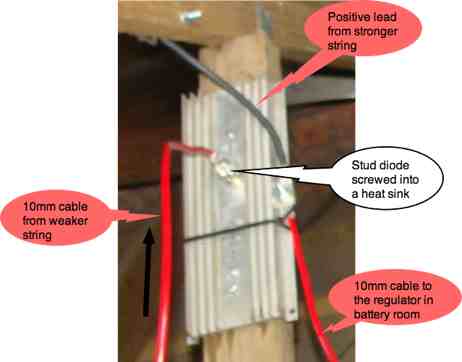
And that may be sooner than you think. Just two years ago, I had no thoughts of solar power energy and today have a quite sophisticated home-built generator.
What might drive you to commit considerable energy and funds to build a solar generator; greed or need? Or perhaps a decision to go green.
First, let's look at greed?
Suddenly your electricity bills are going through the roof and you
discover, perhaps for the first time, that Mr Golden Sun donates to us on a
daily basis a free gift; all that you have to do is
collect it, and manage it. Think solar powered generator.
Or, as in my case, perhaps need is the driving force.
Through gross mismanagement, a steady, clean supply of electrical
energy is no longer available in South Africa. So, as we say in the local lingo, a farmer must make a plan; so must everyone.
Solar is suddenly in, and there's an explosion of development and energy going into the industry; and rightly so. Global warming is certainly not a myth, and we ignore the environmental scientists at our peril.
More important, our children's future is at stake.
So, every month things are changing in your and my life; and not just new smartphones, tablets and computers. Whilst capturing solar power energy is not for everyone, it's had me in a thrall; enter how diodes work.
When I started my solar powered generator, only three years ago, 90 watt photo voltaic panels were the cheapest and best. Here's my first solar experiment; four small PVs providing on a bright day enough energy to run my modem, apple computer and a few light emitting diode lamps, and that's all.
On a dull day like today, they would be quite inadequate, as I soon discovered. That was the first big mistake I made, and was poorly advised. If you are going into solar you'll be disappointed if build a small system. I was and I've met many others who are equally grumpy; nothing less than 3000 watts of panels.
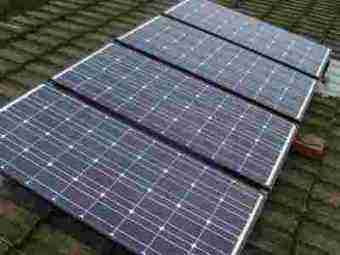
How diodes work
How diodes work explains how a simple device stops a more powerful set of PV panels driving the solar power energy the wrong way down a weaker array.
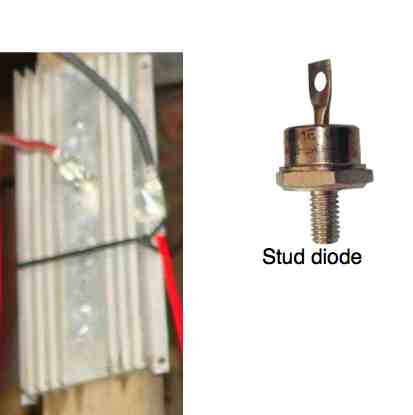
Here they are; four 90W panels in series, providing enough energy to supply my Apple computer. You'll need something bigger for a PC, as they use more than double the energy; and then there's the modem and a few LED lights.
Then greed and need kicked in simultaneously. I began to appreciate my benefactor, Mr Golden Sun, for the first time, and the free gifts he came bearing. And that Mr Grey Cloud had other ideas on occasion. We needed more panels.
But 90W panels were no longer in vogue and, for 30 percent cheaper, only 185W were on offer from my supplier. More important, they were at a different voltage.
And no matter how I did the mathematics, the new panels would have a different voltage to the first set, driving the current the wrong way down the old set of PVs. Enter a friend, a retired physics teacher with a lot of experience. Asked he, do you know what a diode is, and how they work?
Apologies, my photography in the confines of the ceiling was not that great. And, solar companies only supply panels with black leads.
That black lead below from the more powerful string is actually from the positive side of the stronger group, and really should be red.
Okay, so how diodes work is our focus today.
For the details, google it, but it is a device that allows electric current to flow in one direction only.
So, placed in series with the weaker, lower voltage panels, a diode prevents the stronger string from bullying his smaller brother.
Both groups in parallel should contribute to your solar powered generator but if they are not matched, then the stronger may force current backwards down the other photovoltaic set.
Is it a matter of greed; the desire for free solar energy or do you actually have a need? Electrical utility companies are required to be able to provide 15 percent more energy on demand than they actually do most of the time, and for a very good reason. If one generator suddenly implodes, a powerline is brought down by a tornado, or some other natural or man made disaster occurs, the whole network can collapse if the utility is underpowered. This happened recently in Kenya when the whole country found itself without power.
Likewise, if your panels are only providing just enough power for your needs, and a cloud passes over the sun then suddenly you're in trouble.
So, I'm about to put a third string of panels to supply our solar generator. And guess what? The panels are now 230W and the voltage again changed. So another stud diode will be needed to prevent the new kid on the street from bullying his two siblings. More thought about how diodes work and should be installed.
Honest truth? They are cheap, about 5 dollars and all you have to know is which direction they allow current. Ask your supplier; it's not rocket science.
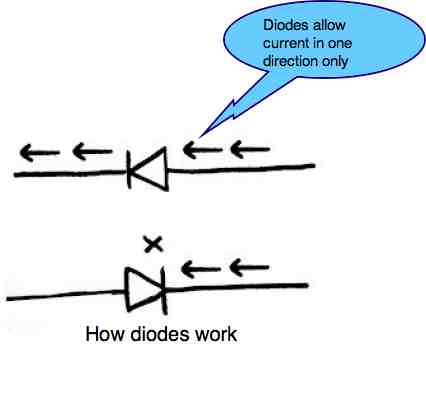
Buy LED light bulbs
One particularly useful application is the light emitting diode. One important change when going green is to buy LED light bulbs. They use about one twentieth of the energy of conventional incandescent lamps. Whilst they require a little getting used to, we'll all be using them before long.
Luckily you do not have to understand how diodes work; just use them.
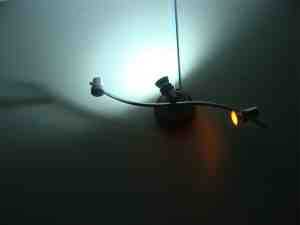
Ladders and arm pain
What on earth does this have to do with the price of tea in China you may well be asking; or how diodes work? I confess I don't have the energy to build a two hundred page website on solar energy generators. So Bernard Preston's site is about my books of chiropractic anecdotes and the other things that enthuse me.
Newsletter
Our newsletter is entitled "create a cyan zone" at your home, preserving both yourself and Mother Earth for future generations; and the family too, of course. We promise not to spam you with daily emails promoting various products. You may get an occasional nudge to buy one of my books.
Here are the back issues.
- Lifestyle and ideal body weight
- What are ultra-processed foods?
- Investing in long-term health
- Diseases from plastic exposure
- Intensive lifestyle management for obesity has limited value
- A world largely devoid of Parkinson's Disease
- The impact of friendly bacteria in the tum on the prevention of cancer
- There's a hole in the bucket
- Everyone is talking about weight loss drugs
- Pull the sweet tooth
- If you suffer from heartburn plant a susu
- Refined maize meal and stunting
- Should agriculture and industry get priority for water and electricity?
- Nature is calling
- Mill your own flour
- Bake your own sourdough bread
- Microplastics from our water
- Alternative types of water storage
- Wear your clothes out
- Comfort foods
- Create a bee-friendly environment
- Go to bed slightly hungry
- Keep bees
- Blue zone folk are religious
- Reduce plastic waste
- Family is important
- What can go in compost?
- Grow broad beans for longevity
- Harvest and store sunshine
- Blue zone exercise
- Harvest and store your rainwater
- Create a cyan zone at your home
Putting up solar panels on your roof is, yes, all about ladders, and ladders are dangerous. At least once in every month or two I have a patient who has fallen off a ladder and done themselves a mischief. That might be arm pain or, the last was a lady who was hanging curtains and fell on her buttocks and fracturing her lower back and causing coccygial pain. She's been lucky and responded well to chiropractic care.
But don't fall off your ladder. Make sure the feet are well anchored, and have someone hold the ladder; it may well save you a lot of misery.
And erecting the scaffolding that holds the solar panels in place requires a lot of drilling and fairly hard physical work. My supplier of solar panels is suffering from quite severe arm pain as he is also installer. The correct word is was suffering. Happily he too has reponded well to chiropractic help.
The moral of the story is warm up your lower back and shoulders and take great care whilst on the ladder and on the roof. You don't have a parachute!
Find the links to those topics highlighted in bold by copying and pasting into the Site Search function in the navigation bar on your left.
Solar power energy
If you have plenty of money and can ask a professional to install a solar generator in your home, well and good.
That solar power energy is free, but if you plan to build your own sunshine generator, some understanding of the physics is important. You don't have to be a whizkid, but you will need to read and talk to others about the ins and outs of solar power energy; that will include how diodes work.
How diodes work: Part II
- How diodes work part 2
USEFUL LINKS
- Solar Power Energy home page ...
Did you find this page interesting? How about forwarding it to a friendly book or food junkie? Better still, a social media tick would help.
- Bernard Preston homepage
- Solar
- How Diodes Work
Address:
56 Groenekloof Rd,
Hilton, KZN
South Africa
Website:
https://www.bernard-preston.com